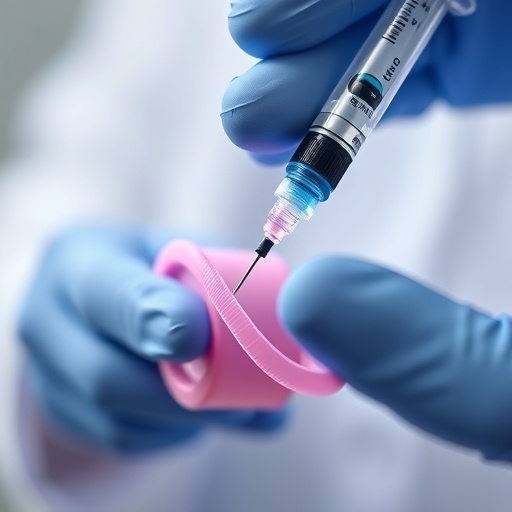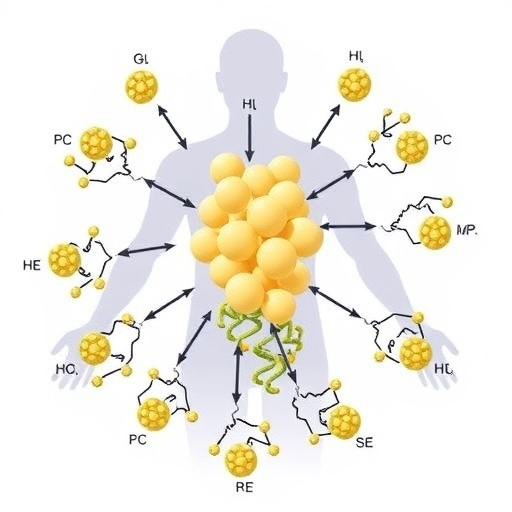In a groundbreaking study that explores the intricate relationship between drug viscosity and tissue biomechanics, researchers have made significant strides in improving the efficacy of needle-free injection systems. This innovative approach comes at a critical time when the demand for non-invasive delivery methods is surging due to patient discomfort with traditional needles and syringes. The study, helmed by Imran, Bajracharya, and Sudhakaran, addresses a pivotal gap in the existing knowledge surrounding the performance variables of needle-free injectors, using advanced skin-mimicking models to simulate real-world conditions.
The study emphasizes that drug viscosity—a key contributor to the flow characteristics of injectable solutions—plays a critical role in the efficiency of needle-free administration. By manipulating the viscosity levels of various formulations, the researchers were able to gauge how these changes affected the delivery dynamics, ensuring that drugs could be administered quickly and effectively without the use of needles. This discovery underscores the need for the pharmaceutical community to prioritize research that maximizes drug delivery speed while minimizing patient discomfort.
Moreover, the interplay between drug viscosity and the biomechanical properties of the skin cannot be overlooked. Human skin is an incredibly complex organ, characterized by its elasticity and resistance, which varies significantly between individuals. By utilizing skin-mimicking models in their experiments, the researchers were able to replicate these properties, facilitating a more comprehensive understanding of how different drugs interact with tissue. This aspect of the research not only broadens the scope of needle-free technology but also emphasizes the importance of personalized medicine in optimizing drug delivery systems.
Equipped with this newfound knowledge, pharmaceutical companies have the opportunity to refine their formulations to ensure maximum efficacy during needle-free injections. The researchers stress that customizing drugs to align with the tissue biomechanics of target populations can lead to enhanced absorption rates and lower the likelihood of adverse reactions. Such adaptations would not only improve patient compliance but may also result in superior therapeutic outcomes.
The study’s implications extend beyond merely improving current needle-free injection technologies. As the industry moves toward creating more sophisticated delivery systems, understanding the fundamental role of formulation attributes, such as viscosity, will be paramount. By providing a set of best practices derived from their findings, the authors aim to guide future research and development efforts, ensuring that advancements in drug delivery keep pace with innovative technologies.
The research team also discusses the role of external factors that may influence drug delivery, including temperature and pressure variations. Their experiments highlighted how a drug’s viscosity could change under different environmental conditions, emphasizing the importance of stable formulations that maintain consistent performance. This aspect of the study indicates that manufacturers should consider these external influences when developing needle-free injectors, ensuring reliability in a broader range of scenarios.
In addition to technical innovations, the social implications of needle-free drug delivery are profound. Many patients, particularly those with chronic illnesses requiring regular injections, report anxiety and discomfort related to needles. By transitioning to needle-free systems, healthcare providers could offer a more compassionate approach to patient care. The emotional and psychological benefit of reducing needle phobia could enhance adherence to treatment protocols, ultimately improving health outcomes.
Consumer education will also play a crucial role in the widespread adoption of needle-free technologies. As patients become more informed about the benefits and performances of these systems, healthcare providers will need to communicate effectively about their use. Understanding the underlying process that ensures these devices work efficiently will empower patients and reduce the resistance they may initially have toward switching from traditional injection methods.
As healthcare continues to embrace technological advancements, the potential for further innovations in the realm of needle-free injections grows. This study represents a critical step in paving the way for ongoing research and development, encouraging a dialogue that bridges the gap between pharmaceutical science and practical applications. The team’s findings serve as a catalyst for future explorations into how we can effectively deliver medications with minimal discomfort to patients.
Moreover, the research aligns with a global movement toward reducing medical waste associated with traditional injection methods. In addition to improving patient experiences, needle-free technologies have the potential to significantly cut down on the disposal issues related to sharps and other injection-related waste. This aligns with environmental sustainability efforts within healthcare, fostering a holistic approach to not only health outcomes but also public health considerations.
The future of needle-free injection systems looks promising as researchers build upon the foundations laid in this important study. By continuing to refine drug formulations and technologies, the healthcare industry has the chance to revolutionize the way medications are administered. Emphasizing a patient-centered approach will be essential in ensuring that technological advancements translate into meaningful benefits for individuals seeking treatment.
As the journey towards effective needle-free injection systems progresses, collaboration between researchers, pharmaceutical companies, and healthcare providers will be key. Fostering a multidisciplinary approach can potentially lead to breakthroughs not only in drug delivery methods but also in overall patient care practices. Pioneering studies like this one will inspire ongoing dialogue and collaboration in the life sciences community, ultimately resulting in a transformation of how we think about medication administration.
In conclusion, the innovative research conducted by Imran, Bajracharya, and Sudhakaran opens up a new frontier in drug delivery systems, elucidating the complex and multifaceted interactions between drug viscosity and tissue biomechanics. As needle-free technologies continue to evolve, the insights gained from this study will undoubtedly shape the future of non-invasive medication delivery—improving patient experiences, enhancing clinical outcomes, and steering the healthcare field closer to a more empathetic and patient-friendly approach to treatment methodologies.
Subject of Research: Needle-free injection performance and its relationship with drug viscosity and tissue biomechanics.
Article Title: Characterizing the roles of drug viscosity and tissue biomechanics in needle-free injection performance using skin-mimicking models.
Article References:
Imran, J.H., Bajracharya, R., Sudhakaran, J. et al. Characterizing the roles of drug viscosity and tissue biomechanics in needle-free injection performance using skin-mimicking models.
J. Pharm. Investig. (2025). https://doi.org/10.1007/s40005-025-00766-2
Image Credits: AI Generated
DOI: 10.1007/s40005-025-00766-2
Keywords: Needle-free injections, drug viscosity, tissue biomechanics, pharmaceutical technology, non-invasive delivery methods, patient compliance.
Tags: advanced skin-mimicking modelsbiomechanics of human skindrug viscosity in needle-free injectionsimproving drug delivery speedinnovative approaches to drug administrationminimizing discomfort with needle-free systemsneedle-free injection efficacynon-invasive drug delivery methodsoptimizing injectable solution flowpatient comfort in drug administrationpharmaceutical research on injection technologiestissue mechanics in drug delivery





